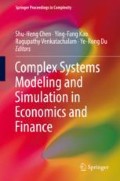Abstract
Based on an Ising model proposed by Harras and Sornette, we established an artificial stock market model to describe the interactions among diverse agents. We regard these participants as network nodes and link them with their correlation. Then, we analyze the financial market based on the social network of market participants. We take the random network, scale-free network, and small-world network into consideration, and then build the stock market evolution model according to the characteristics of the investors’ trading behavior under the different network systems. This allows us to macroscopically study the effects of herd behavior on the rate of stock return and price volatility under different network structures . The numerical simulation results show that herd behavior will lead to excessive market volatility. Specifically, the greater the degree of investor’s trust in neighbors and their exchange, the greater the volatility of stock price will be. With different network synchronization capabilities, price fluctuations based on the small-world network are larger than those based on the regular network. Similarly, price fluctuations based on the random network are larger than those based on the small-world network. On the other hand, price fluctuations based on both the random network and the small-world network firstly increase and then decrease with the increase of the average node degree. All of these results illustrate the network topology that has an important impact on the stock market’s price behavior.
Access this chapter
Tax calculation will be finalised at checkout
Purchases are for personal use only
References
Arifovic, J. (1996). The behavior of the exchange rate in the genetic algorithm and experimental economies. Journal of Political Economy, 104, 510–541.
Lettau, M. (1997). Explaining the facts with adaptive agents: The case of mutual fund flows. Journal of Economic Dynamics and Control, 21(7), 1117–1147.
Kirman, A. (1991). Epidemics of opinion and speculative bubbles in financial markets. In Money and financial markets (pp. 354–368). Cambridge: Blackwell.
Johnson, N. F., Hart, M., Hui, P. M., & Zheng, D. (2000). Trader dynamics in a model market. International Journal of Theoretical and Applied Finance, 3(03), 443–450.
Iori, G. (2002). A microsimulation of traders activity in the stock market: The role of heterogeneity, agents’ interactions and trade frictions. Journal of Economic Behavior & Organization, 49(2), 269–285.
Harras, G., & Sornette, D. (2011). How to grow a bubble: A model of myopic adapting agents. Journal of Economic Behavior & Organization, 80(1), 137–152.
Kim, H. J., Kim, I. M., Lee, Y., & Kahng, B. (2002). Scale-free network in stock markets. Journal-Korean Physical Society, 40, 1105–1108.
Liang, Z. Z., & Han, Q. L. (2009). Coherent artificial stock market model based on small world networks. Complex Systems and Complexity Science, 2, 70–76.
Alfarano, S., & Milaković, M. (2009). Network structure and N-dependence in agent-based herding models. Journal of Economic Dynamics and Control, 33(1), 78–92.
Tedeschi, G., Iori, G., & Gallegati, M. (2009). The role of communication and imitation in limit order markets. The European Physical Journal B, 71(4), 489–497.
Barabási, A. L., & Albert, R. (1999). Emergence of scaling in random networks. Science, 286(5439), 509–512.
Watts, D. J., & Strogatz, S. H. (1998). Collective dynamics of small-world networks. Nature, 393(6684), 440–442.
Sornette, D., & Zhou, W. X. (2006). Importance of positive feedbacks and overconfidence in a self-fulfilling Ising model of financial markets. Physica A: Statistical Mechanics and Its Applications, 370(2), 704–726.
Acknowledgements
We wish to thank Xuezhong He for useful comments and discussions, and anonymous referees for helpful comments. None of the above is responsible for any of the errors in this paper. This work was supported by the Fundamental Research Funds for the Central Universities under Grant No. 2012LZD01 and the National Natural Science Foundation of China under Grant No. 71671017.
Author information
Authors and Affiliations
Corresponding author
Editor information
Editors and Affiliations
Rights and permissions
Copyright information
© 2018 Springer Nature Switzerland AG
About this paper
Cite this paper
Zhang, Y., Li, H. (2018). Price Volatility on Investor’s Social Network. In: Chen, SH., Kao, YF., Venkatachalam, R., Du, YR. (eds) Complex Systems Modeling and Simulation in Economics and Finance. CEF 2015. Springer Proceedings in Complexity. Springer, Cham. https://doi.org/10.1007/978-3-319-99624-0_9
Download citation
DOI: https://doi.org/10.1007/978-3-319-99624-0_9
Published:
Publisher Name: Springer, Cham
Print ISBN: 978-3-319-99622-6
Online ISBN: 978-3-319-99624-0
eBook Packages: Economics and FinanceEconomics and Finance (R0)

